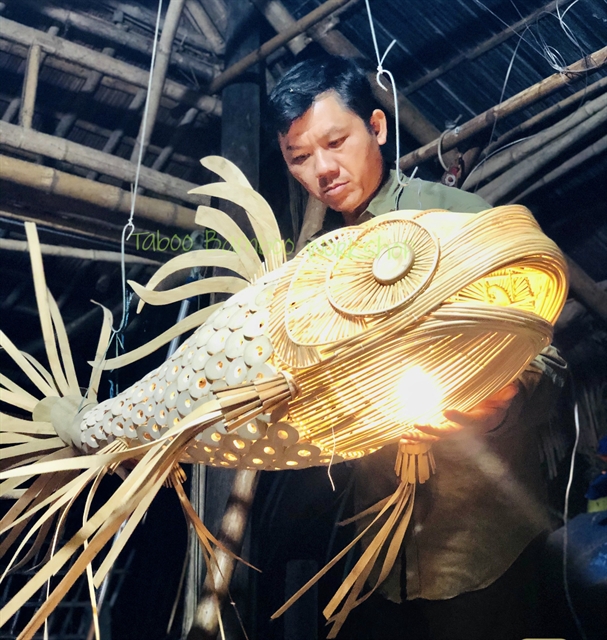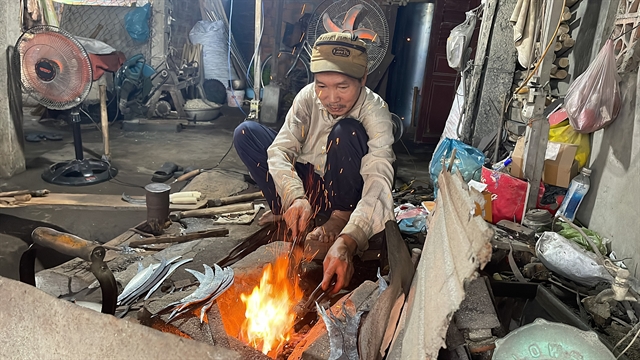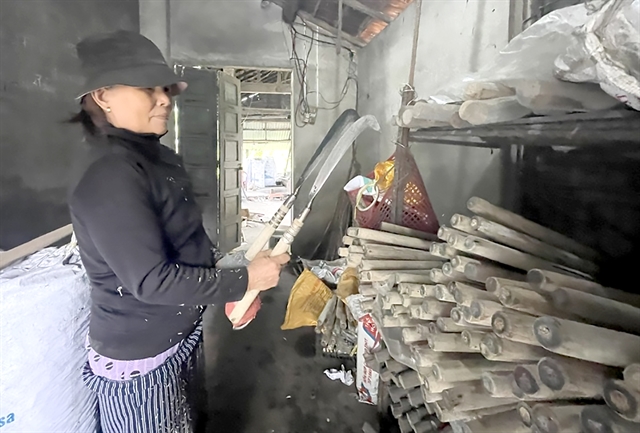 Life & Style
Life & Style

 |
| Craftman Nguyễn Đô heats the iron to shape the product. — Photos baogiaothong.vn |
QUẢNG NGÃI — Amid the rapid rise of science, technology and the influx of cheaper, mass-produced goods, many traditional industries are struggling to survive.
But in Quảng Ngãi Province, you'll find one small village bucking the trend.
Minh Khánh, a forging village with a legacy spanning over three centuries, still stands strong, thanks to the timeless wisdom passed down through generations.
After the Lunar New Year, the path leading to Minh Khánh village in Tịnh Minh Commune, Sơn Tịnh District, buzzes with activity.
Here you will see people carrying hammers, pickaxes, hoes and knives all forged by their own hands.
Despite the changing times, the village's age-old craft continues to captivate not just locals but also visitors.
Phạm Tấn Hiệp, an experienced craftsman, confidently said that despite the rise of high-tech farming equipment flooding the market, the products from traditional villages continue to sell well, and farmers still trust them.
"Not every tool can match the trust and artistry consumers crave," Hiệp told Giao Thông (Transport) newspaper.
"Especially with traditional items like knives, hoes and pickaxes, durability, sharpness and the right weight are key factors. These are age-old secrets, passed down through generations of blacksmiths, refined over time,"
Blacksmith Nguyễn Đô, 61, believes that although the golden age of the forging village has passed, the spirit of craftsmanship still blazes on.
Nowadays, forges no longer mass-produce but primarily work on bespoke orders, with craftsmen pouring their hearts into every step of the process.
He said: "Forging a hoe isn't just about heating and shaping metal; it's about understanding the heat and force to create the perfect tool. This knowledge is passed down through generations, a treasure trove of family wisdom that technology can never replicate."
Thanks to these age-old secrets, the forging village continues to thrive, its craftsmen adapting to modern times while staying true to tradition.
Each household specialises in crafting specific tools, from hoes to hammers, maintaining their unique identities in a changing world.
Today's forges have applied technology for labour-intensive tasks like cutting, shaping, and grinding.
This blend of tradition and innovation ensures that the flames of the forging village continue to burn bright for generations to come.
Head of the Management Board of Minh Khánh traditional forging village Nguyễn Tòng said that there are currently 65 households in the village making a living from forging. Some households earn a respectable income of VNĐ500,000-600,000 per day, while others make less, around VNĐ300,000.
In some exceptional cases, they can earn millions of đồng per day.
"Every item crafted in our village is still treasured," he said.
Nguyễn Đình Thân, an elderly craftsman, added: "In the past, there was no trade in this region that brought in as much income as forging. That's why other regions referred to this forging village as a place of prosperity. While it may not rake in the riches like it used to, but it still brings in money."
The unique feature of Minh Khánh traditional forging village is its lack of signage or advertisements, unlike other craft villages.
 |
| A local woman with agricultural tools produced in Minh Khánh forging village. |
Nguyễn Hoàng, aged 76, a blacksmith with decades of experience in the trade, said: "This village has been around for 300 years. Despite our village's long history, we've never relied on flashy marketing. Instead, each product proudly displays the mark of the forge or the craftsman, allowing customers to easily recognise its origin."
In the past, ancestors chose to engrave their names on each product as a form of "marketing" to reach customers.
While working together in the fields, locals naturally shared their goods with one another, relying on word of mouth to determine which forge was reliable.
This led to each household developing its own unique techniques for crafting agricultural tools.
Hoàng said his family specialised in making scissor blades.
More than ten years ago, farmers cultivating lychees and cotton in northern provinces like Thái Bình and Hải Dương came here to order scissors.
Later, they even sent people to learn the trade and set up forges in their hometowns.
However, Hoàng noticed that despite receiving his training, some of his apprentices couldn't replicate his craftsmanship when they returned to their villages.
"I passed on all my knowledge to my apprentices, but perhaps they couldn't fully grasp it. This trade may seem simple, but it's not. That's why many traditional craft villages have dwindled over time. Yet, Minh Khánh forging traditional village along the Trà Khúc River, which has endured for 300 years, still survives to this day," Hoàng said.
Minh Khánh forging village has now been officially recognised as a traditional craft village by the Quảng Ngãi Provincial People's Committee. The village's products have been recently awarded a 3-star OCOP certification. — VNS




